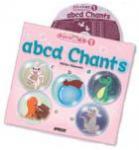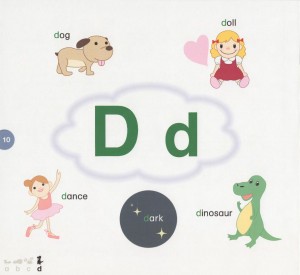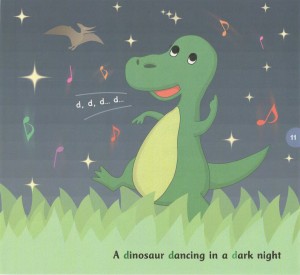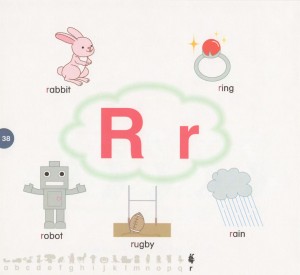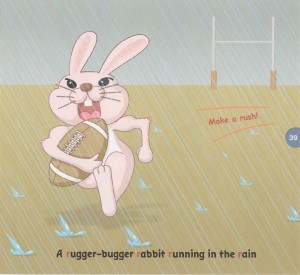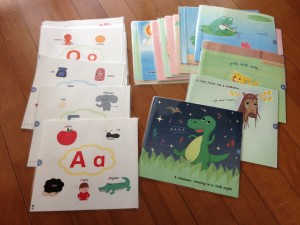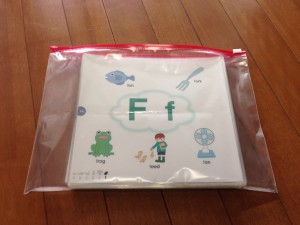

abcd Chants
I’m going to start off by saying that I absolutely love “abcd Chants”. It may be one of my favorite books in the Picture Books by Chants series. If it is not my favorite, it is definitely the book that I use the most.
I can still remember the day that I first got a copy of it. We had just moved back to Japan after living in the States for 2 years. I was setting up my room for my English classes. My daughter Hana, who was 3 1/2 at the time, saw “abcd Chants” and asked me to read it to her. I told her I didn’t have time right then, but would read it for her later. Obviously, she didn’t like this answer. So I put the audio CD in my computer for her and told her to follow along with the CD. I continued setting up my room. The next time I looked over at her, she was already on ‘W’ and completely absorbed in the book. This experience is partially responsible for leading me to use the picture books audio in my classes more.
Anyway, fast forward a few months and I introduced the book to one of my classes. It was successful until about ‘F’ or ‘G’, when the kids became restless and lost interest. What I realized then is that it was just too long to use straight through from A to Z for most Japanese kids. It is hard to focus on new English for that long at one time.
Since then, I have very heavily integrated “abcd Chants” into my phonics program. (I’ll write more about my current phonics program later.) I love that the book introduces more words (five words) for each letter and my students love the drawings and short chants for each letter.
They especially love “A dinosaur dancing in a dark night”.
You can hear the audio for it here.
And since a few of them play rugby, “A rugger-bugger rabbit running in the rain” is also highly requested.
We usually focus on between 4-5 letters at a time. I play the audio and look at the pages for whichever letters we are focusing on. Originally, I was using the book, but kept thinking that what I really wanted were cards that had the letter on one side and the chant on the other. Finally, I bought 2 more copies of “abcd Chants”. I carefully cut the binding off using a cutter and a ruler. Then, because the letter and picture pages are on a spread – not reverse pages, I used a bit of nori tape to tape the pages together. (Only put a bit on the end you will feed through the laminator first, otherwise you’ll end up with wrinkles.) Then I slid the pages into laminating film and laminated them. Now, instead of flipping through the book to the page I want to use that day, I can hold up the card for that letter. It also allows me a bit more control because, using the book, sometimes kids get distracted by the picture page and don’t focus on the words page.
There are also games that I can play with the cards…
Put the cards out letter side up and say the chant. The students have to find the right card.
I also do a kind of rock-scissors-paper game (I’m sure there’s a Japanese word for it…). I put out the letter cards in a line. Two students start at opposite ends of the line. The students have to say the sound and word for the letter, then go to the next card and do the same. When they meet in the middle, they have to do rock-scissors-paper. The loser (or the next person on the loser’s team) starts over and the winner continues. The game ends when one team gets to the other end of the line. I usually play twice, having the teams switch ends so they get practice with all the letters. I have used cards with just letters for this game in the past, but using my “abcd Chants” cards would be better for students who are having a hard time remembering what sound the letter makes.
I’ve thought about buying another book or two to cut up and make a classroom alphabet border with, but I don’t have much wall space in my current classroom. An idea for the future…
You can hear audio for some of the other letters on the Audio Samples page.
Peanut Butter and Jelly
My preschool students who are studying WELCOME to Learning World PINK absolutely LOVE the Student CD. They listen to it in the car all the time. They (and their younger siblings) know all of the songs from the book long before we ever “play with” them in class. They especially love the Peanut Butter and Jelly song which is in Unit 8. It’s a real favorite. And it is even more fun for the students because the final activity with the song is making real peanut butter and jelly sandwiches! None of them had had peanut butter and jelly sandwiches before, so they really looked forward to this.
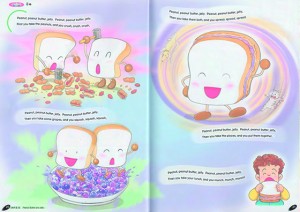
The first thing we did was to sing the song using gestures. We used gestures almost like in the sample video.
The kids loved singing the song with the gestures!
The next thing is that I like to take the gestures a step further. I make a set of “bread”, “peanut butter”, and “jelly” for each of the kids. My teacher’s set is laminated for longer use, but the students’ sets are not. To make them, I print the sheets on paper, use “tape nori” on one half, fold the paper in half so the sides line up, and cut out the parts.
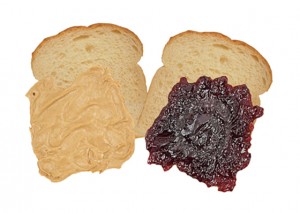 Peanut Butter and Jelly PDF
Peanut Butter and Jelly PDFFollowing the lines of the song, students:
- Pick up the peanut butter and make the crushing gesture.
- Pick up the jelly and make the squashing gesture.
- Pick up one piece of bread, put the peanut butter on it, and make the spreading gesture.
Pick up the other piece of bread, put the jelly on it, and make the spreading gesture. - Put the pieces of bread together with the peanut butter and jelly in the middle.
- Pretend to eat their sandwich.
The students had a lot of fun with this. But the next part was even more fun! Using skinny sandwich bread, we made real peanut butter and jelly sandwiches. With the song playing on repeat in the background, we made sandwiches. When the verse for the step we were on played, I would emphasize it and the students would say it. They were very happy to have peanut butter and jelly sandwiches with a glass of milk.
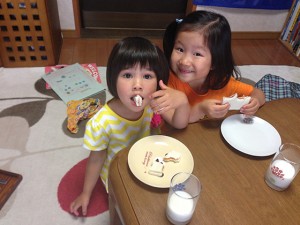
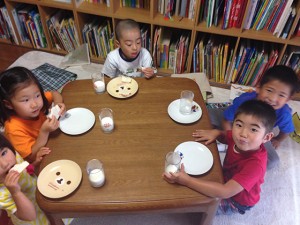
We also used language like:
- Bread, please. Peanut butter, please. Jelly, please. Milk, please.
- Thank you.
- Can I have more?
- It was good. It was yummy.
This is one of my favorite lessons because it is really fun for the students, they get to really use the language and do something with it. Also, it is fun for me to share a bit of my childhood with them. They can get a bit of American culture.
** I did make sure to ask the moms about food allergies and make sure it was okay to feed them in the couple of weeks before the lesson with food.
Where? When? How?
I love using games in class! There are a couple of really great points about using games.
- Students have fun while practicing the target language.
- Games are a great chance for teaching and using “other” English.
This “other” English is stuff like negotiating whose turn, understanding the rules of the game, and checking that they’ve understood the rules while playing the game. In the past, I used to use more Japanese in class than I do now. I would sometimes explain the rules in Japanese so that we could spend more time practicing the target language. But then I went to one of Matthew de Wilde’s presentations and it made me think about the importance of this “other” language. So, now I use less Japanese in class.
This game is one that I developed with Learning World 2, Unit 6, Lesson 2. I used the Activity Sheets for this lesson to introduce the language and had the students sort the cards into the correct categories of “where”, “when”, and “how”. This was great, but I wanted to make a game to practice more. I often use small playing cards to play games. I have lots of games for pairs and a good one for 4-card sets, but this time I had 3 categories… I finally came upon the perfect idea: Clue!
The original Clue game is a murder mystery game. Someone has murdered the owner of the mansion. The board has nine rooms, there are characters and weapons. The winner has to correctly guess who did it, with what, and where.
The Activity Sheets had 9 places. Perfect! So I made a new game. The basic rules of the game are that you take one card from each category and hide them in an envelope. That is the answer. You deal out the remaining cards. Any card that you have in your hand is not in the envelope, so you can mark it off on your score sheet as not being the answer. During the game play, students move from room to room. Each time, they enter a room, they can make a guess. The guess includes one item from each category. Students have to guess by saying something like:
“Let’s go to the park on Sunday by bike.”
If the first student to their left has one (or more) of the cards, they have to show it just to the student making the guess. And if they have more than one, they can pick the one to show. If the first student does not have any of the cards guessed, then it moves on to the next student. As you see cards from other students, you can mark them off on your list. When only one item is left you know that that one item is the answer for that category. Once you know all of the items, you can make a final statement. If you are right, you win. If not, the rest of the students continue playing.
We didn’t completely finish the first game in the 50-minute class. It took them about half of that time to really get the rules. Once they got the rules, it was like a light bulb went off. The next class, we spent the entire 50 minutes playing the game. With 4 people playing that is about how long it took. You might think, “50 minutes just playing one game?!?” But the students loved it and were having fun. They were using lots of English! And not just the target language. There were things being said, like:
“Whose turn is it?”
“Do you have one of those cards?” “Do you have one?” “I’m sure you have it!”
“No, I don’t have one.” “Oops. I do have one.”
“Hey! You have that card!” (At the end of the game, after a student had made a mistake during the game.)
Here is everything you need to make the game yourself, including detailed instructions for making and playing the game!











